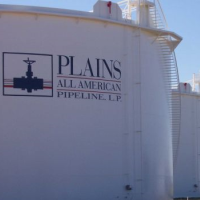Santa Barbara Oil Spill Fits Nicely on Company’s List of Safety Problems
 (photo: Plains All American Pipeline)
(photo: Plains All American Pipeline)
Governor Jerry Brown declared a State of Emergency near Santa Barbara Wednesday, where estimates of oil that flowed into the ocean from a ruptured pipeline quintupled in a day to 105,000 gallons.
There was nothing official about the early estimate of the now-nine-mile-long slick that started just west of Refugio State Beach, and drifted down the coast as the authorities scrambled to contain the impending environmental disaster and figure out what happened. They will, no doubt, have questions for the operator, Houston-based Plains All American Pipeline, which apparently has a lot of experience answering questions about safety and maintenance.
The Los Angeles Times did a quick database check at the U.S. Pipeline and Hazardous Materials Safety Administration (PHMSA) and found Plains had three times the number of infractions per mile of pipeline than the national average. They were fifth on a list of 1,700 pipeline operators in the total number of infractions.
Reporters counted 175 infractions in multiple states since 2006, including pipeline corrosion, operator error and pump failure. More than 688,000 gallons of hazardous materials were spilled during the incidents, causing $23 million in damage. Plains was dinged for relying on local fire departments, instead of maintaining adequate firefighting capabilities, and failing to install required anti-corrosion equipment.
PHMSA penalized Plains $115,600 for its indiscretions.
Earlier this month, the U.S. Environmental Protection Agency (EPA) sent Plains a 10-count notice (pdf) of Clean Air Act violations at a new oil-by-rail facility near Taft in Kern County. The EPA said the San Joaquin Valley Air Pollution Control District incorrectly assessed how noxious it would be to bring in up to two of the dangerous mile-long oil trains per day.
If the district assessed the plan correctly, the facility would have been labeled a major polluter and triggered a more public review under the California Environmental Quality Act (CEQA), the EPA said. The facility has been operational since November 2014.
A lawsuit by environmentalists in January alleged that Plains and the district worked together to minimize public awareness of planning for the rail terminal.
The pipeline transportation company is big. Its website says Plains controls 18,900 miles of oil and natural gas pipelines, 8,100 rail cars, 2,890 trucks and trailers, 149 transport and storage barges, 72 transport tugs, and 125 million barrels of storage capacity. The company reported an $878-million profit in 2014 on $43 billion in revenue.
The pipeline that ruptured transports oil from ExxonMobil’s Las Flores Canyon Processing Facility near Refugio to the Plains-owned Gaviota pumping station, according to the Santa Barbara Independent. It can move 50,400 gallons of oil an hour. Oil gushed for hours on Tuesday afternoon—flowing into a culvert on its way to a storm drain and ultimately the Pacific—before the slick was spotted and the oil operator was alerted.
Plains is sticking with its early assessment of 21,000 gallons, according to National Public Radio (NPR).
–Ken Broder
To Learn More:
Pipeline Operator in Oil Spill Has High Rate of Safety Infractions (by Julie Cart, Jack Dolan and Doug Smith, Los Angeles Times)
As Refugio Oil Slick Spreads, Spill Estimate Rises (by Tyler Hayden, Santa Barbara Independent)
EPA Faults Air District's Approval of Oil Train Terminal near Taft (by John Cox, The Bakersfield Californian)
Oil Spill from a Pipeline near Santa Barbara Coats the Shoreline (by Ken Broder, AllGov California)
- Top Stories
- Controversies
- Where is the Money Going?
- California and the Nation
- Appointments and Resignations
- Unusual News
- Latest News
- California Forbids U.S. Immigration Agents from Pretending to be Police
- California Lawmakers Urged to Strip “Self-Dealing” Tax Board of Its Duties
- Big Oil’s Grip on California
- Santa Cruz Police See Homeland Security Betrayal in Use of Gang Roundup as Cover for Immigration Raid
- Oil Companies Face Deadline to Stop Polluting California Groundwater





